#common types of pigmentation
Explore tagged Tumblr posts
Text
Pigmentation Treatment That Works: Restore Your Natural Glow
Do you ever find yourself staring back at your reflection, seeing those dark spots and uneven patches on your skin? Not at all flattering right? They weren’t there before, and now, they seem to leave you alone. What to do? Well, there’s a simple answer to that, get an effective pigmentation treatment in Noida and get your glowing skin back with a touch of refreshment to it. Skin pigmentation issues, such as dark spots, melasma, and sun spots, are actually quite common and can be caused by hormonal changes, sun exposure, or age.

However, with the right treatment, you can get your beautiful skin back along with its natural glow. This blog will walk you through the causes of pigmentation and the best treatments available to help you achieve flawless skin.
Understanding Pigmentation — What’s Really Causing Them?
Before we go ahead and jump into learning about the treatments, it’s essential that we first understand what causes pigmentation changes in the first place. Skin pigmentation can happen when the skin produces too much melanin, a component liable for your skin colour. Here are the most common types of pigmentation:
Melasma: This is quite common and caused by hormonal changes, such as during pregnancy. You can see brown or grayish patches appear on the skin, especially on the face. It can also be triggered by taking birth control pills or hormone therapy.
Sunspots: As the name suggests, these are caused by prolonged exposure to UV rays from the sun. The sun’s UV rays can damage your skin, leading to brown and tan spots on the skin.
Freckles: Small, flat brown marks that appear on fair skin, also triggered after sun exposure. The sun triggers an increase in melanin, which can cause more freckles. They are not really harmful to the skin but can cause harm to your confidence.
Aging Spots: These are usually developed as you age and are called liver spots or age spots. They are dark marks that appear with increasing age.
They don’t just cause cosmetic issues but also have an impact on your self-esteem. So, it is always better to get a suitable treatment and stop before the condition worsens.
Pigmentation Treatment Options That Work
Now, that we are talking about pigmentation treatment, you have several options available for you. The best treatment depends on the type of pigmentation and the severity of the issue. Here are the most effective treatments:
Laser Treatment
The most popular and effective treatment for pigmentation is laser therapy. Under this treatment, the expert uses a laser to break down the pigment in the skin. The body then naturally removes the broken-down pigment.
Chemical Peels

Chemical peels involve applying a solution to the skin that exfoliates the outer layer, removing dead skin cells and giving you fresh new skin underneath. It helps lighten pigmentation by promoting skin rejuvenation and reducing the appearance of dark spots.
Vampire Facials

Now this one is the most popular among other pigmentation treatments, as it uses your own blood and its special properties (PRP) to treat the condition. This offers a more natural and effective solution for pigmentation. Also, along with this, vampire facials are a good anti-aging treatment.
Microdermabrasion

Microdermabrasion is a method that gently exfoliates the top layer of skin to help reduce the pigmentation in your skin. In this procedure, the expert uses a device to spray tiny crystals onto the skin, and then exfoliate the surface. In the end, you are left with a smoother and even skin tone.
Now, you can only know which treatment is ideal for your skin with a detailed consultation with an expert dermatologist. A skin specialist will carefully assess your skin condition and suggest more appropriate treatments, suitable for your specific skin requirements.
Consult The Best Skin Doctor in Noida
When it comes to effective and safe pigmentation treatment in Noida, Skinologics Clinic stands out as a trusted name. This advanced skin clinic is led by some of the best skin doctor in Noida and provides the latest and some of the most effective treatments to help you restore your skin’s natural glow. You can expect a variety of skin treatments from laser treatment to chemical peels to various other anti-aging treatments.

Don’t wait any longer! Start your journey to a radiant, even complexion today!
Original Source:- https://skinlogicsclinic.wordpress.com/2025/04/08/pigmentation-treatment-that-works-restore-your-natural-glow/
#beauty#Best Skin Doctor in Noida#common types of pigmentation#pigmentation Causes#Pigmentation Treatment#Pigmentation Treatment in Noida#Pigmentation Treatment Options#skin-care#skincare-routine#Skinologics Clinic
0 notes
Text

Have you ever seen a white Common Raven (Corvus corax)? No, this isn’t a new species… or a ghost. 👻 This Raven’s striking pale plumage is the result of the genetic mutations leucism or albinism. Leucism is a reduction in all types of pigmentation, including melanin. Albinism is the inability to produce or distribute melanin. One hint to tell the difference? Individuals affected by leucism often have blue eyes, while individuals with albinism have pink eyes. White Common Ravens are rare. An estimated 1 in 30,000 individuals is born without this species’ signature black plumage.
Photo: Cos van Wermeskerken, CC BY-NC 4.0, iNaturalist
#science#nature#natural history#animals#fact of the day#did you know#cool animals#albinism#leucism#raven#ornithology#birds#white raven
6K notes
·
View notes
Text
The essential skincare acids guide


type of acids sheet
Salicylic Acid – Best for oily and acne-prone skin. It penetrates deep into the pores, unclogs blackheads and whiteheads, controls excess oil, and prevents breakouts.
Glycolic Acid – Ideal for normal to oily skin. It exfoliates the top layer, brightens the skin, improves texture, and reduces fine lines and hyperpigmentation.
Lactic Acid – Suitable for dry and sensitive skin. It gently exfoliates while providing hydration, making it great for dullness and rough texture without irritation.
Mandelic Acid – Best for sensitive and acne-prone skin. It helps with uneven skin tone, reduces breakouts, and provides mild exfoliation without irritation.
Azelaic Acid – Works for all skin types, including sensitive skin. It reduces redness, fades hyperpigmentation, treats acne, and calms rosacea.
Kojic Acid – Best for hyperpigmented and sun-damaged skin. It helps lighten dark spots, melasma, and discoloration caused by acne scars or sun exposure.
Tranexamic Acid – Ideal for all skin types struggling with stubborn pigmentation. It effectively reduces melasma, post-inflammatory hyperpigmentation (PIH), and sunspots.
Hyaluronic Acid – Suitable for all skin types, especially dry and dehydrated skin. It deeply hydrates, plumps fine lines, and retains moisture for a youthful look.
Polyglutamic Acid – Great for dry and dehydrated skin. It locks in moisture, provides long-lasting hydration, and enhances the skin’s elasticity.
Ascorbic Acid (Vitamin C) – Best for dull, uneven, and aging skin. It brightens, reduces pigmentation, fights free radicals, and boosts collagen production.
Ferulic Acid – Works for all skin types, particularly those using Vitamin C. It enhances the antioxidant power of Vitamin C and E, preventing premature aging.
Ceramides (Fatty Acids) – Essential for dry and sensitive skin. They repair and strengthen the skin barrier, preventing water loss and irritation.
Linoleic Acid (Omega-6 Fatty Acid) – Ideal for acne-prone and oily skin. It reduces clogged pores, balances oil production, and supports a healthy skin barrier.
Ellagic Acid – Good for sun-damaged and aging skin. It protects against UV damage, brightens skin, and provides antioxidant benefits.
Cinnamic Acid – Suitable for all skin types. It has anti-inflammatory properties and helps protect against environmental damage.
Succinic Acid – Best for oily and acne-prone skin. It controls sebum production, fights acne-causing bacteria, and soothes inflammation.
How to choose the right skincare acid for ur skin type
Oily & Acne-Prone Skin
Salicylic Acid (BHA): Penetrates deep into pores to remove excess oil and prevent breakouts.
Azelaic Acid: Reduces acne, fades dark spots, and calms redness.
Succinic Acid: A gentle anti-inflammatory that helps control breakouts.
Dry & Dehydrated Skin
Lactic Acid (AHA): Exfoliates while hydrating the skin.
Hyaluronic Acid: Retains moisture and plumps the skin.
Mandelic Acid: A mild exfoliant that improves texture without drying.
Combination Skin
Glycolic Acid (AHA): Brightens skin and smooths texture.
Salicylic Acid (BHA) (my bff🦅) : Controls oil production in the T-zone.
Hyaluronic Acid: Hydrates dry areas while balancing oil.
Sensitive Skin
Mandelic Acid: A gentle AHA that exfoliates with minimal irritation.
Azelaic Acid: Soothes inflammation and reduces redness.
PHA (Polyhydroxy Acids): Provides mild exfoliation while boosting hydration.
Hyperpigmentation & Dark Spots
Kojic Acid: Brightens skin and reduces discoloration.
Tranexamic Acid: Fades stubborn dark spots and melasma.
Glycolic Acid (AHA): Speeds up cell turnover for an even skin tone.
Aging & Wrinkles
Glycolic Acid (AHA): Stimulates collagen production and smooths fine lines.
Ferulic Acid: Enhances antioxidant protection and stabilizes vitamin C.
Ascorbic Acid (Vitamin C): Brightens skin and fights free radical damage.
Common Mistakes When Using Skincare Acids
Using skincare acids can transform your skin, but when used incorrectly, they can cause irritation, sensitivity, or even worsen skin concerns. Here are some common mistakes to avoid:
1. Over-Exfoliating
Many people think using glycolic or salicylic acid daily will give them faster results, but excessive exfoliation weakens the skin barrier. This can lead to redness, peeling, breakouts, and sensitivity. (especially for oily skin)
Solution: Use exfoliating acids (AHAs/BHAs) 2-3 times per week and always listen to your skin. If it feels irritated, take a break pleaaase
2. Skipping Sunscreen
Acids like glycolic, lactic, and salicylic acid increase your skin’s sensitivity to the sun. Without SPF, you risk sunburn, premature aging, and even worsening of dark spots.
Solution: Always use a broad-spectrum SPF 30+ sunscreen daily when using serums with those acids.
3. Mixing the Wrong Acids
Not all acids work well together. Using too many active ingredients in one routine can cause irritation.
🔴 Examples of bad combinations:
Vitamin C + AHAs/BHAs → Can cause irritation and weaken Vitamin C’s effectiveness.
Retinol + AHAs/BHAs → Too harsh on the skin, leading to peeling and sensitivity. (by experience 💁🏻♀️)
Niacinamide + Vitamin C (unless properly formulated) → Can cause flushing or reduce effectiveness.
Solution: Use exfoliating acids on alternate days and simplify your routine to avoid irritation.
4. Not Hydrating Properly
Exfoliating acids remove dead skin cells but can also strip away moisture. Without proper hydration, the skin can feel tight, dry, or irritated.
Solution: After using acids, apply thick a moisturizer to maintain balance especially if the acids dry ur skin so fast
@bloomzone
#bloomtifully#bloomivation#girl blogger#bloomdiary#luckyboom#lucky vicky#wonyoungism#becoming that girl#creator of my reality#dream life#divine feminine#glow up#it girl#wonyoung#self growth#self love#self care routine#self care#skincare routine#skincare#get motivated#matcha girl#self improvement#blogging#girl blogging#tumblr girls#girlhood#girly stuff#clean girl#dream girl journey
1K notes
·
View notes
Text
i already was seeing a lot of Jason with albinism stuff but there's been a significant uptick in it since the Thalia casting announcement and I wanted to say: please please PLEASE do actual research about albinism if you're gonna make headcanons about Jason being albino. I have already seen so much ignorant and ableist stuff about it because nobody is bothering to do any research and it's really annoying.
A couple of major notes:
There are different types of albinism!!!!! and no i'm not referring to vitiligo or etc. Just straight up albinism there are different types. There are two main types (oculocutaneous albinism types 1 and 2) plus ocular albinism, and then some other types as well that are even rarer. It is also possible to have only partial absence of melanin. (Vitiligo is a form of partial absence/loss of melanin, and often involves loss over time)
Albinism is a lack of melanin/pigmentation. This affects sensitivity to light and UV rays a LOT. Like a lot a lot. (This also applies to vitiligo btw! Melanin protects your skin from the sun, so a loss of melanin even in patches means those areas are more sensitive!)
Skin sensitivity to sunlight does not only apply to when it is sunny out. People with albinism have to take a lot of steps to protect their skin because they are SIGNIFICANTLY more susceptible to sun/UV damage. It doesn't matter if it's overcast, raining, snowing, whatever. They are putting on sunscreen, and they are putting on a lot of it. Sun protection can also come from just covering up. Big hats are also popular choices.
Sensitivity to light also applies in all environments. Transition glasses are common and sunglasses are common.
People with albinism do not have red irises. A lack of pigmentation in irises (referred to as ocular albinism) appears blue, usually a very light blue (less melanin/pigmentation in the eye, the lighter blue it appears). The red appearance comes from more light entering the eye than usual, causing a red eye effect like you see in flash photography except with the naked eye. This can make the iris appear slightly pink/red-tinted and will more often make the pupil look reddish instead of pure black because you are seeing into the eyeball itself and the muscles and veins within it. Not everyone with albinism has blue eyes depending on how much the pigmentation in their eyes is affected, but a lot of people do.
Albinism basically always includes the individual having vision problems, usually low vision or outright being legally blind. They are not completely blind but it is very likely they are legally blind. We're talking very thick glasses (though glasses don't always help because of what causes the low vision), requiring enlarged text, i know somebody who had a little glass block that magnified text underneath it and they used that a lot, etc etc. Depending on severity they may require other assistive devices. Albinism affects the optic nerve, so other eye conditions like strabismus and nystagmus (and more) are also extremely common if not a guarantee (nystagmus is basically always guaranteed).
Nystagmus, for those who don't want to bother googling it, is uncontrollable eye movement in the form of back and forth shaking. Strabismus is when your eyes don't align with each other. These also cause vision impairment.
If you are writing Jason as having poor vision from albinism, he would KNOW he needs glasses. Literally everybody should know he needs glasses/is blind. He would likely be legally blind and would have been pretty much his entire life. He would also almost definitely have other eye conditions as well. (Also rip Jason being raised by the wolves, poor guy is gonna have the WORST sunburn)
People with albinism have different skin tones! And different hair colors! A lack of pigmentation looks different depending on your individual genes and what type of albinism you have! Look up photo references!!!!!
There is also a lot of fetishization of albinism. PLEASE BE RESPECTFUL when you are making headcanons about it, or creating/designing characters who are albino.
Here's a couple of short tiktoks that go over some basic information and other stuff about albinism if visual-auditory learning is more your jam: [1] [2] [3] [4] [5] [6] [7] (Kayla_lud has a lot of videos going over information about albinism)
okay now everybody take your notes and go tweak your headcanons yeah? yeah. okay good.
526 notes
·
View notes
Text
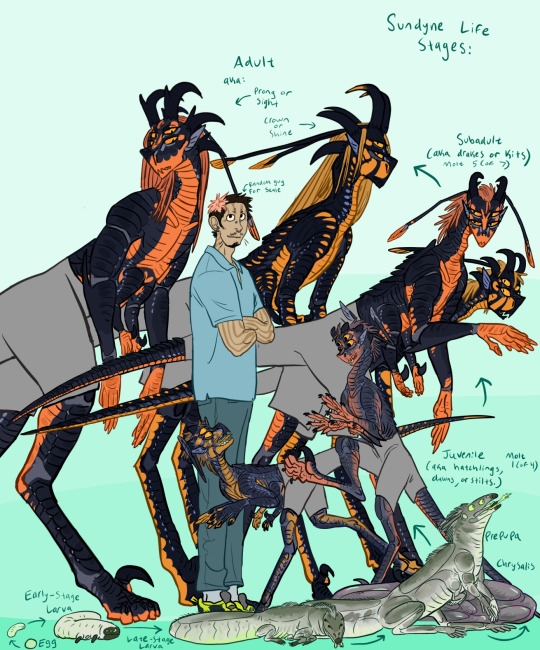
Now, time for the grub to giant creature speedrun. Oh and there's a guy with stripes there too.
The sundyne life stages are:
'Egg, Early-Stage Larva, Late-Stage Larva, Prepupa, Chrysalis, Juvenile (aka hatchlings, dawns, or stilts) molt 1 (of 4), Subadult (aka drakes or kits) molt 5(of 7), Adult (adult females can be called prongs or sights while adult males can be called crowns or shines)'
Here's some more info:
They follow a pretty similar process to Drecu. Clutches are around 6-12 eggs that the female lays on the male’s lower back/hip area (they're held in place with the male's big gonopods)
Larva are soft n squishy. As they’re growing, they look almost identical to Drecu (even their extra little arms are hard to notice because they stay under the body most of the time) the most noticeable difference is the prepupa size and darker coloring, which sometimes aren’t as pronounced as a drew here. Sundyne grow Very fast (multiple individuals have noted that it’s pretty painful during the juvenile and subadult stages). Unlike Drecu, how they emerge from the chrysalis depends on good ol’ genetics rather than pheremones/enzymes. Even freshly pupated, there is a notable difference between male and female that continues on to subadult and adult stages. They're called dawns because of their muted coloring, or stilts because of their disproportionate leg and arm length.
Not all adult females have these, but the one I drew has those branches on her horns as an indication of fertility/matriarch status. Reproductive females will drop their horns and regrow them with this new feature; the more clutches they have, the greater the size and number of prongs. Nonreproductive females might drop and regrow their horns due to environmental changes (such as better nutrition or isolation from other sundyne), but they won’t get the prongs.
Males can’t shed their horns at all! However, as you can see here, they are generally more brightly colored and yellowish than females. The male pictured here actually has an absolutely goated color scheme, he’d be seen as extremely attractive and popular thanks to his dark black and prominent yellow coloration. They see yellow as their special royal color, since that pigment is what makes their signature bright orange patterns (as opposed to the simple red of Rox. The black is actually just a very dark blue). I was playing around with how much yellow tone the average Sundyne could have, as opposed to the mutation where they *only* have the yellow color (an extreeemely special and cool thing for them)
Misc fun facts:
-The random guy for scale has several splice traits going on at once: stripes, whiskers, and naturally growing pink hair! This is pretty common (I just haven’t drawn a lot of humans for example XD). Now that they aren’t being monitored or intentionally tailored, these naturalized gene mods just mix n match randomly.
-he’s not pictured here duh, but the current Seru (Emperor) has the all-yellow mutation, which was part of why he was able to take the other clans by storm ( thanks to that “born holy” type charm that they just couldn’t ignore. ). His giant angry wife, however, is fairly standard as far as Sundyne females go.
-As you could’ve guess from what I just said about the average Sundyne egg clutch size, Maro actually *had* around 5 blood-siblings from the same clutch as her! I wonder what happened to them…
#weird lookin dinosaur#Sundyne#theyre so hard to drawwww#original species#alien species#speculative biology#xenobiology#spec evo
230 notes
·
View notes
Text

Maids, servants and how they dress
Practically every fortress-type nest has nobles leading it, and nobles bring along a whole swarm of various minions. Cooks, cleaners, gardeners, butlers - they all occupy the "mansion" part of the nest where their masters separate themselves from the commoners.
The ones working outside tend to fly a lot. Nest walls are littered with various access hatches that allow the servants to move quickly through the superstructure, but these entrances are not exactly spacious or comfortable to go through. For this reasons the ones running errands outside the "mansion" tend to go topless to not restrict their wings and for general ease of movement.
The lasses wear a simple skirt with pockets and puffy underpants. Just petticoat isn't an option or they'd be accidentally mooning passerbys as they fly by. A lot of the time they also wear aprons which may range from simple rectangular ones to as ruffly and heavily decorated as their master is willing to shell out for.
The lads dress themselves in wide pants with thicker form fitting bottoms made of rough leathery materials, as well as similarly thick corset-like band. It has no purpose beyond aesthetic. They wear aprons as well, but they're usually worn to the side when not actually needed.
Leading this cohort of servants are seniors, they rarely leave the noble's area and take on more of an administrative role rather than doing much menial work themselves. It's reflected in their dress, generally more showy and restrictive. The matrons wear floor-length skirts with a long large-sleeved underdress. Their male counterparts meanwhile gain darker dress shirts and more elaborate leather accessories - the band and the cuffs.
Common servants and maids can also take on fancier outfits when they stick around in the mansion and don't need to fly to get around. A woman's getup can be modified with an underdress similar to the matron's but it's not floor length. A male servant only needs a dress shirt to make himself more presentable.
All their clothes are color-coded to make them easier to pick out among the crowd. It can be just about any hue depending on a particular noble's taste, but orange is extremely prevalent due to the pigment used for dyeing being bright and fairly cheap.
599 notes
·
View notes
Text
WHO WANTS TO KNOW ABOUT WEIRD SEA ANIMALS???
1.) Sea Angels
They look like angels but they are predators. They’re a type of sea slug and the muscle that’s common in Gastropods was modified to help them adapt to swimming! They’re also pretty small ranging from 1.2-8.5 centimeters. Their translucent because they are very deep in the sea and the pigmentation found in animals on earth and in the higher waters is just used to protect them from UV rays. But since Sea angels are so deep in the ocean, the sun isn’t visible to them meaning they don’t need pigmentation. That goes for a lot of deep sea animals. They also glow!

2.) Vampire Squid
So Vampire Squids are called vampires because they are so bony and are a deep red color that led to people thinking they suck blood. But they are actually detritivores! This means they eat dead organic matter so they are not as scary as people make them out to be. They have the largest eyes to body ratio of any animal! Vampire Squids are cephalopods, meaning they should have the muscles to change colors, but they don’t! They’re so cool, I love them!

3.) Barreleye Fish
Man are these things fugly, but in a cute way! Like Sea Angels, Barreleye Fish have a translucent head! The strange thing though is that’s it eyes are inside of it. They seems to be humongous but that because, like the Vampire Squid, they live in the deep deep ocean where it’s dark. They need the largest eyes possible to take in the most light! As scary as they look, they only get up to six inches so you have nothing to worry about. (You wouldn’t be that deep in the ocean anyway😒)

Guys if anyone actually enjoys this stuff please tell me cause I would love to make more! These are so fun and I love animals! Especially marine ones. So yeah!🤭
#marine life#marine biology#fish#squid#true facts#fun facts#interesting facts#random facts#animals#biology#ocean#sea#like for more#please#😭
301 notes
·
View notes
Text
[♂] scars.
Having Mars in an aspect with the ascendant, the ruler of the ascendant or Venus shows that you can be prone to having scars. The sign in which Mars is in can show the type of scars you are most prone to getting. I'm writing this focusing mostly on facial scars, but it can also apply on scars on other parts of the body.
Aries Mars can give all types of scars, since it's the sign related to them, but the most common types of scars are red spots and marks or scars that are in the form of a straight line.
Taurus Mars gives scars that affect the surface of your skin - scars are either pitted or raised, which causes your skin to be uneven when you look at it or touch it.
Gemini / Virgo / Capricorn Mars gives small scars. Gemini and Virgo are related to smaller things in general, while Capricorn is the sign of limitation and restriction, which can result in a smaller scar.
A Cancer Mars can play out in two ways, giving you scars that affect the texture of your skin, such as pitted/raised scars or scars that leave spots of pigmentation, such as red or brown spots.
Leo and Libra Mars gives hyperpygmentation scars - they don't affect the surface of your skin, but they leave darker spots.
A Scorpio or Sagittarius Mars can give you very noticeable scars. Scorpio is the sign of extremes and Sagittarius - of expansion, so these signs can give you very big or dark scars. Sagittarius influencing your Mars can also give you raised scars, while Scorpio - pitted.
Aquarius Mars can give very unique or unusual scars. Nothing is off limits here, so along with Aries, this is the sign that can give all sorts of scars.
A Pisces Mars is most prone to giving hyperpigmentation scars, like brown or pink scars or pitted scars.
Other factors also come into play when it comes to scars, such as other aspects to your ascendant, its ruler or Venus, as well as the degree at which Mars is. ☽
#astrology#divination#witchblr#spirituality#astro notes#astro observations#horoscope#zodiac signs#beauty#fashion#style#mars#aries#taurus#gemini#cancer#leo#virgo#libra#scorpio#sagittarius#capricorn#aquarius#pisces
1K notes
·
View notes
Note

There’s this lovely duck couple that I’ve been trying to properly ID for weeks now - my current guess is one is leucistic and the other got some genes from a domestic species (lots of farms around here)
But yea they’re very pretty and I thought you might enjoy them :>
Yeah, those sure look like Manky Mallards! Thank you so much for thinking of me! the brown-bodied male is a classic, classic Manky Mallard with domestic ancestry. That pattern and body shape are very very common in drakes with hybrid ancestry.
This is COMPLETELY ANECDOTAL and not at all scientific, but in my experience, that specific type of drake (large, plump, heavy, coloured dark brown, with a green head and a broken white bib) is considered EXQUISITELY HANDSOME to wild Mallards of all sexes.
The presumed-female is a little trickier. Could even be a male (ducks can have same-sex couples and personal lives of extraordinary messiness and complexity.) As I said the other day, something we recognise in domestic animals is that pigmentation is a spectrum, but in wild animals we tend to just say "leucistic" to explain the range of pigment loss between wild type and albino. Domestic animals have fancy words the interactions of pigment and pattern along the spectrum (you'll hear of "smoky cream" horses and be shown a sparkling metallic gold horse and told that it's a type of black horse; cat people are mashing together words like "dilute lilac tortoiseshell"; etc etc.)
A leucistic female mallard can have varying levels of pigment loss, ranging from looking like a slightly paler wild duck, to being "blonde" with practically no pattern whatsoever. Here are two purportedly-leucistic female mallards from stock image banks on google showing this variety.


An important determiner is that leucism typically affects the brown pigment in ducks. it seems to operate less on the black pigment (so most leucistic mallards will still have some visible traces of their pattern). (you can have leucism in ducks that takes away the black lineart, of course, it's just that it's more common that it reduces the brown fill colour.)
and usually leucism should not be operating on the blue wing patch, which - as nerds will know - is a structural colour rather than a pigment, and less affected. Domestic duck breeds and colours often don't have the blue wing patch. Another determinant for domestic lineage is animal behaviour, but - ducks being so messy and weird at all times - this is really difficult to call.
You'd need to collect some more sightings to be sure, but based on the lack of pattern and there not being a wing patch, I think there's domestic heritage in the paler one too.
At any rate it's a fabulous sighting of Manky Mallards, a birdwatching phenomenon I enjoy very much. thank you!
99 notes
·
View notes
Note
Do you know any good sources for burn scar care?
I’m writing a character who was burned in a spaceship crash. The story is set several years after the fact, and I want to incorporate that detail into the story. What would a burn scar care routine look like?
Hey!
I generally recommend medical websites for this kind of stuff. There are tons of information readily available online, especially about things as common as a burn injury. Phoenix Society for Burn Survivors or MSKTC can be helpful for you.
While caring for a burn scar will be different for everyone (there's many types, degrees, plus just individual differences between burn survivors themselves) some of the things that you can include;
Burnt skin doesn't produce its own oils, so it gets dry. It needs to be moisturized, oil-based products (think coconut or grape seed oil) are often used. The heavier the lotion, the fewer times a day it needs to be applied.
Massaging a scar, especially when it's relatively new. It can be a massage, but stretching or just putting pressure on it is part of that too. It helps the skin from becoming extremely sensitive. Initially you do it delicately, but after the scars are matured it's fine (or recommended even) to put some force into it. This loosens them up.
Itching is a huge issue. Both massaging and moisturizing help with that, but if it's still causing problems then there are medications that could provide some relief.
Protecting the skin from the sun. All year, including cloudy weather. Sunblock, big hats, sunglasses if needed, all that. This applies to people with darker skin as well because the skin loses its pigment after a burn (it can sometimes come back but it's definitely not a guarantee).
Avoiding the heat. A lot of burn survivors will have problems with temperature regulation because burns damage the sweat glands, so they overheat faster. There's nothing burn-specific here, same protocol as for avoiding a heatstroke - drink water and keep out of the sun.
Wearing softer and looser clothing. Rough and tight clothes can cause blisters, and that is a Problem. Inappropriate materials could also induce more itching.
Taking pain meds. Chronic pain is common, so your character might need medication.
I definitely wouldn't say that this is an exhaustive list, but I think it's a good start. If you need more details, I think the resources linked above should work.
I'm glad to see people interested in burn scars being a disability that requires a lot of care rather than seeing it as a solely visual thing. Makes it much more authentic.
I hope this helps,
mod Sasza
475 notes
·
View notes
Text
Yeah I had Wardi use of eyeliner on a routine/cross-gender basis as canon for ages but routinely forgot to depict it ever. And then once I remembered it was also like.. I can't just suddenly drop this look now with no context

It has intended practical functions of protecting the eyes from the glare of the sun and from other sources of damage/contaminants/ailments. Certain styles are considered beautifying and/or formal and may be worn for predominantly cosmetic reasons.
Most eyeliners are derived from soot or charcoal and worn as a thin paste (mixed with small amounts of butter, oil or animal fat and water). What exactly the black pigment derives from (which kind of plants or type of animal's bones/ivory is burnt to produce it) entails more specified medicinal benefits. More expensive eyeliner utilizes powdered malachite or lapis for blue-green hues.
The use of eyeliner in of itself has no gender or class connotations, but the specific styles worn (and materials used) do.
The people you see wearing it on a daily basis are peasants and other laborers (ESPECIALLY sailors and fishermen) who are likely to be in bright outdoor conditions. Field laborers tend to smudge the eyelids all around and a little above each eye while seamen tend to wear a black stripe across both eyes (though exact styles often vary regionally).
Men apply it in combat (regardless of season/sun conditions) and thick black eye makeup is a part of the cultural image of warriorhood. It is generally thought to look both handsome and intimidating, poetry describing it often contrasts a combatant's masculine beauty with the fearsome evocation of a skull's empty eye sockets. This specific style is what's pictured here, and it's not one you're supposed to wear in regular life unless you can claim status as a blooded warrior (he actually can).
Other styles worn by noblemen usually set themselves apart from those of field laborers via design (a sort of cat-eye look with a long tail is common) and/or more expensive pigments being mixed in, usually lapis for dark blue hues. Most noblemen don't wear this style on a daily basis unless they're public officials, it's considered an aspect of formal dress for special occasions.
Women who are Not outdoor laborers wear it for predominantly cosmetic and/or medicinal purposes. The proper feminine variant that won't make you look like a peasant or like you're trying to be masc or like you're Too Slutty is very delicate and small lines contouring the eyes.
#That drawing of the Wardi cataphract should have had eyeliner. Realizing that after the fact was what made me go like OH SHIT I'VE#BEEN FORGETTING THAT WAS A THING..#Couya Faiza Janeys and Brakul are all wearing it on a regular basis during the events of whitecalf because they're all traveling outdoors#through the peak of summer.#Palo does too but only has a small supply and has to use it more sparingly or try to bum some off soldiers.#Hibrides is wearing it too but the style that isn't Peasantesque/masc/Too Slutty#WAIT I THINK I POSTED BRAKUL WEARING IT AGES AGO#Though refined the stylistic variants since then#janeys haidamane
83 notes
·
View notes
Text
Flora of the Vreem Home World
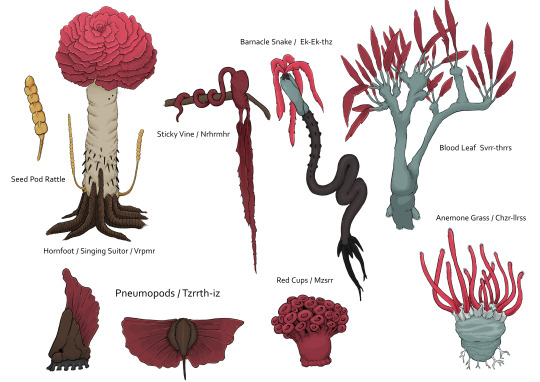
Flora on the vreem home world is more closely related to fauna, as the two share the same phyla. This is because, the origins of multicellular photosynthesis is fundamentally different than earth's.
Unlike on earth where eukaryotic photosynthesis evolved via symbiosis with cyanobacteria this process never occurred on their home world. Instead their version of photosynthesis developed later as a type of membrane bound protein structure in the earliest ancestor of both their flora and fauna phyla. As a result the flora across the vreem home world is more closely related to their animal life than those on earth.
Here's a collection of different flora-fauna your might come across on the vreem home world. Most flora use a red photosynthetic pigment in their foliage, but other pigments such blue-green and even gold are also found across the world and are typically more common among aquatic species. Each species is listed with an earthling name along side its Onomatopoeia derived from Khllk, a commonly spoken vreem language.
Singing Suitors "Hornfoots"
Evolved from a worm like ancestor, their leaves are modified gills filled with the red photo-sensitive pigment used in their process of photosynthesis. They get their name in khllk due to the rattle like "seed pots" which when blown in the wind produces a sound similar to a "Vreem" chirp. They are colloquially called hornfoots by humans, as their root structures are made of heavily ossified tissue baring a resemblance to horns. Water is drawn from the soil through capillary action similar to trees on earth. Hornfoots are a relatively primitive group of floral type fauna as they retain a central cavity, mouth, and two simple compound eyes. They protect their fills by pulling them inwards into their central cavity.
Sticky Vines Predatory flora are common across their homeworld. Sticky Vines, typically hang from the stocks / branches of other flora and use their two sticky oral arms to snag flying pray. While their too small to be considered a threat to the vreem, their oral arms are difficult to spot in the red jungles they grow in, and as a result they often present a collision hazard below the canopy
Barnacle Snakes Are a related species to sticky vines, whoever they retain more of their ancestral form. They typically grow rooted to a larger structure, a rock face or another large flora species. They share a similar gill structure like hornfoots, but theirs are sticky. They're predominately air filter feeders, surviving mostly on spores and small bugs. Unlike hornfoots they have a complete gut.
Land Corals Red Cups, Anemone Grass and Blood Leafs are three flora species which are from colonial clade. They individual flora which are comprised of smaller specialized clones which function together as a single organisms. This tends to give them a more "plant-like" appearance, similar to other colonial animals like corals on earth.
Pneumopods This group of animals tend to occupy the "insect / bug" niches like those of arthropods of earth They're very small organisms no larger than a human fingernail. However their biology share more in common with echinoderms (starfish / sea urchins) than insects. They have an endoskeleton comprised of plates as a row of tube feet for locomotion. These two have photosynthetic spiney membranes. The species on the right are gliders and feeds on the hemolymph of other flora.
68 notes
·
View notes
Text
Cat color genes masterpost
I copied all my descriptions from the cat color gene tournament here, with pictures and all. I often type out the genotypes, so this is a guide to what each letter means. Under the cut because it's very long.
Disclaimer: Sometimes I don't use the most common designations of a gene or an allele, and I'd like to apologize to everyone who's bothered by this. I have a very good reason for it: I like it better my way.
Genetics guide
Agouti (agouti signaling protein gene, ASIP): this gene determines whether the individual hairs will be banded or not.
dominant allele: A - banded hairs, tabby cat (wild type)
recessive allele: a - no bands, solid cat (variant)
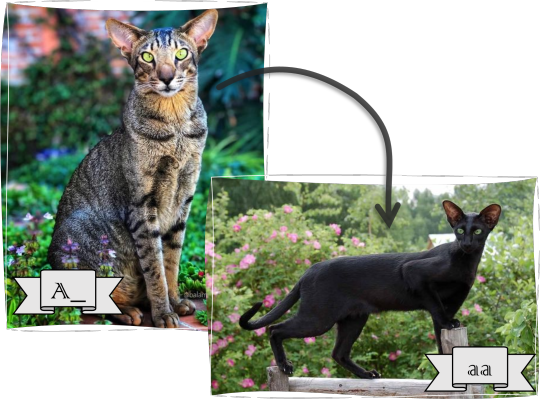
A_ means if there's already an A allele, the other one can be either A or a.
A homozygous recessive cat with wild type alleles on every other gene will be solid black. Combined with other allele variants the a allele can produce other solid colors, different types of smokes and several more.
Actually there are more "secret" alleles for this gene: the agouti alleles of the asian leopard cat and other wild feline species. In certain hybrid breeds, most notably bengals, there's even a special coloration called charcoal born from the combination of the domestic cat's solid and the asian leopard cat's agouti allele.
Ticked (dickkopf wnt signaling pathway inhibitor 4, DKK4): this gene determines if there is any full-colored hairs, or only banded.
dominant allele(s - researchers found at least two): Ti - only banded hairs, ticked tabby cat (variant)
recessive allele: ti - some hairs don't have bands, "patterned" tabby cat (wild type)

If this is the only gene with variant allele, we'll have a black ticked tabby [black tabbies are also called brown, and other, mostly breed-specific names]. Ticked tabbies are possible in every color.
Nonagouti covers up the tickedness (this is called recessive epistasis): we won't see what a solid cat's genotype is on this gene. (Except when other genes make it possible. But that's biology for you.)
Spotted (?): this hypothetic gene can break up the tabby pattern's stripes into spots.
dominant allele: Sp - spotted tabby cat (variant)
recessive allele: sp - striped tabby cat (wild type)
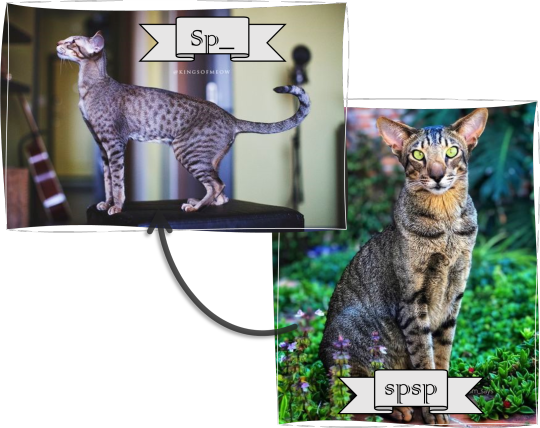
Alone the Sp allele makes a black (brown ect) spotted tabby cat; of course, in combinations with other variant alleles, it can produce a wide variety of different colored spotted tabbies.
Both a and Ti covers up the spotted gene: its effect normally only visible on a cat with the A_ titi genotype.
Mackerel [i use the name mackerel since every other gene here is named after the dominant allele] (transmembrane aminopeptidase Q, Taqpep): this gene determines the type of the tabby pattern.
Blotched and classic are synonym terms.
dominant allele: TMc - narrow vertical lines, mackerel tabby cat (wild type)
recessive allele: tbl - wide, swirling lines, blotched or classic tabby cat (variant)
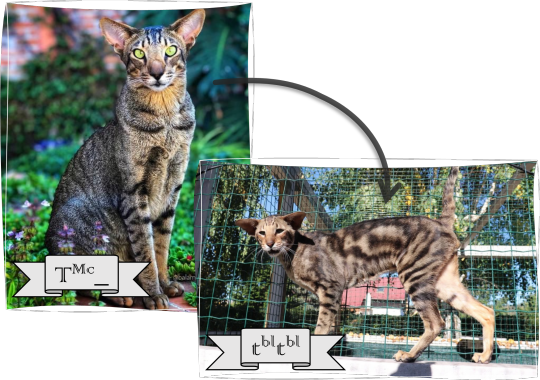
If every other gene is wild type except this, we'll have a black blotched tabby cat, but of course the tbl allele can produce lots of different colored classic tabbies.
All of the previously mentioned genes are able to nullify the effect of this one, so a mackerel or a blotched tabby must have A_ titi spsp genotype.
Additional annoyed remark: Despite the name, the so-called classic pattern is actually both the newer and the less common worldwide. My only guess for why it's named like that: it's the more common one in England. Well, thanks. (That's why I actually prefer the name blotched over classic.)
Brown (tyrosinase-related protein-1, TYRP1): this gene determines the quantity of the functional eumelanin.
dominant allele: B - full pigment production, black cat (wild type)
"middle" allele: b - less pigment, chocolate cat (variant)
recessive allele: bl- even less pigment, cinnamon cat (variant)
Order of dominance: B > b > bl
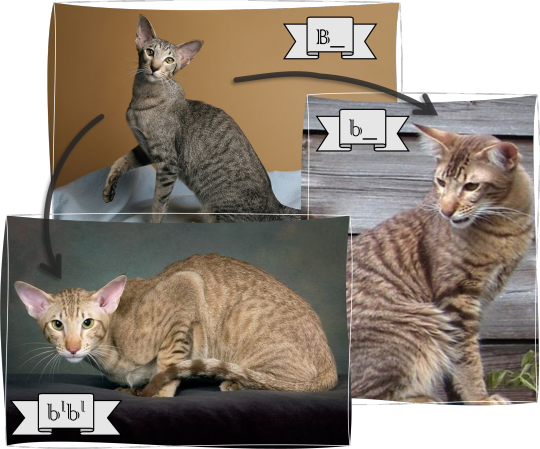
If every other allele is wild type except this, we'll have a chocolate or cinnamon mackerel tabby cat. (On the picture the cinnamon cat is spotted rather than striped, because i couldn't find a decent mackerel. So sad.) Chocolate and cinnamon cats are possible in every pattern.
Dilute (melanophilin, MLPH): this gene determines the distribution of the pigments.
dominant allele: D - even pigment distribution, dark cat (wild type)
recessive allele: d - clumped, uneven pigment distribution, diluted cat (variant)
black -> blue
chocolate -> lilac
cinnamon -> fawn

In these pictures the difference isn't that striking between the black and the blue mackerel tabby, but if you look up at the header, in solid cats it's much more pronounced.
For further comparison of undiluted and diluted color pairs on one picture (to eliminate differences in lightening):
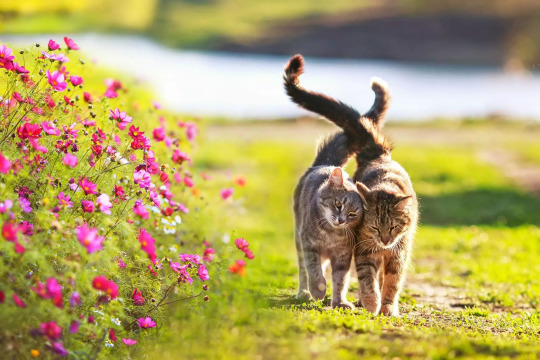
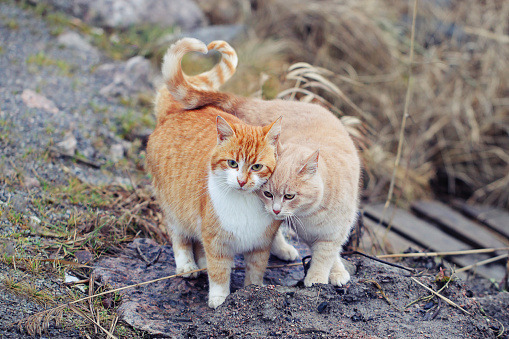
black vs blue and red vs cream
Every possible color and pattern can be diluted (with the only exception of white).
Orange (?): this yet unidentified gene determines the type of the most prominent pigment: eumelanin on pheomelanin.
allele: O - mainly pheomelanin, red-based cat (variant)
allele: o - mainly eumelanin, black-based cat (wild type)
This gene is special in two related ways: first, it's located on the X chromosome, which means tomcats only have one allele; second, the alleles are codominant - if a cat carries both of them, it'll show both phenotypes: this is how we get tortoiseshell cats. This explains why almost all tortoiseshell cats are females - every tortie needs two different X chromosomes.

Combined with other variant alleles every possible color and pattern can occure as tortoiseshell, but the O allele is epistatic over a lot of genes: for example agouti (the phenotype of every orange cat is tabby, even the genetically solid ones) and brown (since eumelanin is mostly absent thus can't change - the genotypes OO B_, OO b_and OO blbl all mean red cat).
The dilute version of red is called cream.
The dilution level is always the same in the colors of a tortoiseshell: the undiluted black, chocolate and cinnamon is paired with red, the diluted blue, lilac and fawn are paired with cream.
White (receptor tyrosine kinase, KIT): this gene determines the size of the area the pigment producing cells (the melanocytes) reach.
dominant allele: W - basically no melanocytes, white cat (variant)
allele(s): ws - limited area is covered, white-spotted cat (variant)
allele: w - all of the body is covered by the melanocytes, full-colored cat (wild type)
recessive allele: wg - only the paws remain white, gloved cat (variant)
Order of dominance: W > ws = w > wg
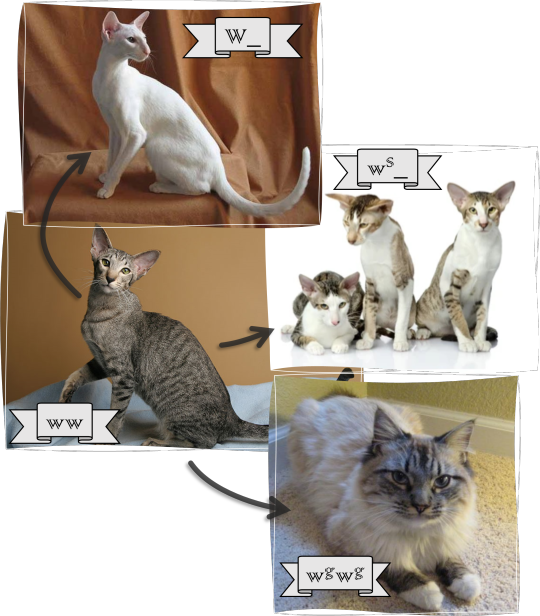
Since the gloving allele is kind of specific to the breed, I used a birman cat to illustrate it.
Lots of alleles here! Actually I'm not sure what's the most accepted opinion about them, but since these variant are all mapped to KIT, I considered them alleles.
If every other gene shows the wild type except for this, we'll have a white, or a white-spotted black mackerel tabby cat, but thanks to the ws allele(s) every color and pattern can be combined with white patches. However, the W allele is epistatic over every other gene: if a cat has one or two copies of W, it will be white regardless everything else.
ws is interesting: it has an additive effect, a cat with the wsws genotype will have more white than a cat with only one copy of it.
wg is fully recessive: the gloved phenotype only present if the cat's genotype is wgwg.
Color restriction (tyrosinase, TYR): mutations on this gene will result in temperature-sensitivity in the pigment production, the cats will be lighter on the warm and darker on the cooler areas of their bodies.
dominant allele: C - regular pigment production, full colored cat (wild type)
allele: cb - moderately reduced pigment production: burmese color restriction, sepia cat (variant)
allele: cm - reduced pigment production, bangkok color restriction, mocha cat (variant)
allele: cs - highly reduced pigment production: siamese color restriction, pointed cat (variant)
recessive allele: c - no pigment production, albino cat (variant)
Dominance order: C > cb = cm = cs > c
Now this group is a lot. Not only five different alleles (mocha was found relatively recently in Thailand), but the middle three are all intermediate with each other meaning that actually we have eight different phenotypes (illustration from messybeast; full color and albino are absent):
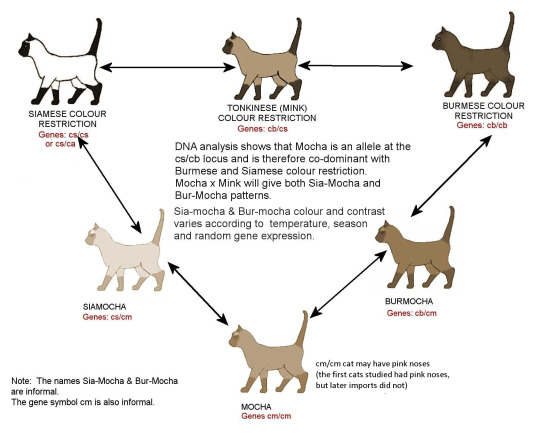
I used solid cats for illustration, because in the thai breed (the cats i used belong to this) they are often preferred over tabbies, so it's easier to find pictures; also, it's much more simple to compare them.
(Photos from The Thai Cat Center and Bangkok Mocha Cat, and Pangur from @pangur-and-grim as an albino cat)
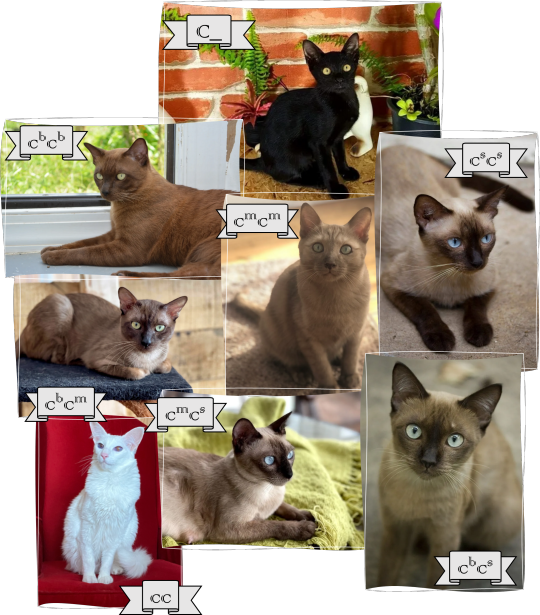
Please note that all of these varieties are very changeable; the pictures (especially those of the heterozygotes) are far from representing all cats carrying the respective genotypes.
Alone these variants makes some type of a black (seal) mackerel tabby point cat, but every type of color restriction can occure together with all possible colors and patterns.
***The color restriction gene won the Cat Color Gene Tournament!***
Inhibitor (?): this unidentified gene reduces the pheomelanin production, thus removes the warm tones of the fur (the hairs have white-black banding instead of yellow-black).
dominant allele: I - reduced pheomelanin, cooler toned cat (variant)
recessive allele: i - normal pheomelanin, warmer toned cat (wild type)
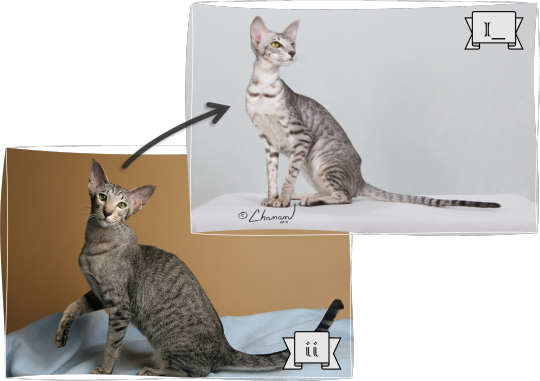
If every other allele is wild type except for this, we'll have a black silver mackerel tabby cat. Combined with other alleles it can produce lots of different silver (tabby) and smoke (solid) varieties.
Wide band (?): This hypothetic gene makes the yellow bands on the agouti hairs wider, resulting in a lighter, yellowish pelt. Based on the width of the pale bands we can differentiate between golden (middle band width) and shaded (maximal band width, color is pushed up into the tip).
dominant allele: Wb - reduced area of eumelanin, warmer toned cat (variant)
recessive allele: wb - normal area of eumelanin, cooler toned cat (wild type)
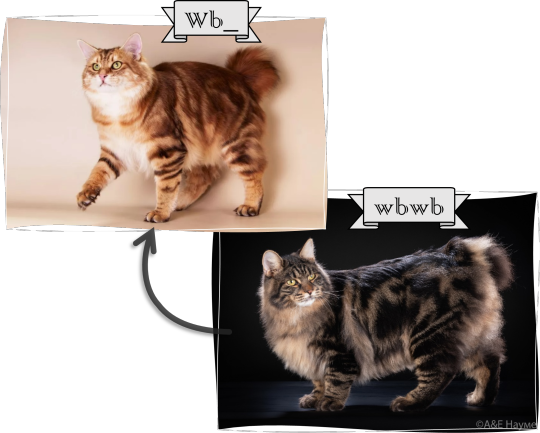
Golden is quite a mess; right now there is one identified gene (found first in siberians), but persians and many more breeds must have different gene(s), based on the interaction with the inhibitor gene (siberian golden + silver = bimetallic, persian golden + silver = silver shaded or chinchilla), and the inheritance patterns (the siberian alleles are recessive, while persian golden appears to be dominant). Since lots of breeds allow golden, and sometimes it can be found even in stray cats, I say who knows what genes and alleles are out there! This is all a hardly understood, very exciting and currently researched area.
If every other gene stays wild type except for this, we'll have a black golden mackerel tabby or a black golden shaded cat. Combined with other alleles it can produce lots of different golden and silver varieties.
Low-grade white (?): Again, hypothetic gene(s). Even with the extreme variability of the white spotting allele(s), the existence of some independently inherited genes is strongly suspected. Their effects most commonly manifest as a white locket: a small white patch on the chest or the belly, and/or a white tail tip. I'm not sure if there is any consensus whether these are more likely to be recessive or dominant alleles.
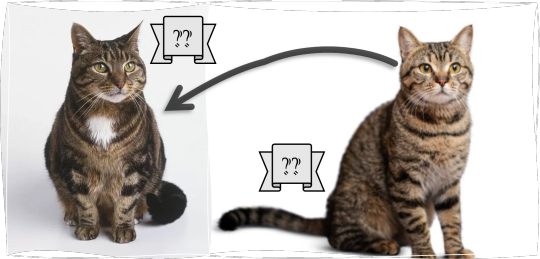
Dilute modifier (?): This unidentified gene changes the color of a diluted cat, the coloration becomes more brownish.
dominant allele: Dm - (variant)
recessive allele: dm - (wild type)
blue, lilac, fawn -> caramel
cream -> apricot
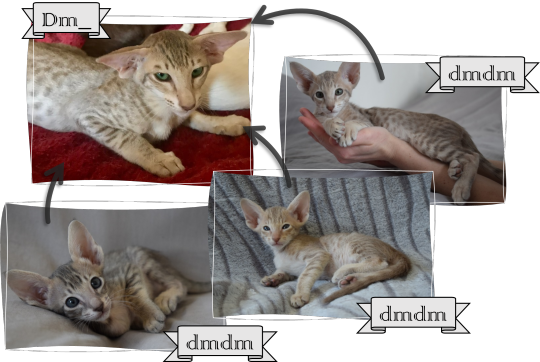
I put here a cat in all three diluted colors to compare them with the caramel tabby. It's hard to spot the differences, isn't it?
Since this is a dilute modifier, the D allele covers it, and we can only see its effect on cats with dd genotype.
It can be found only in a few breeds: orientals (including related breeds), burmese, different rexes. To our current knowledge, of course.
Extension (melanocortin 1 receptor, MC1R): This gene replaces eumelanin with pheomelanin resulting in a yellowish or reddish furred cat. The change often happens gradually during the first years of the cat's life.
dominant allele: E - eumelanin remains, black adjacent cat (wild type)
recessive alleles: e, er, ec - pheomelanin takes over, yellow/red adjacent cat: amber, russet or serdolik (variant)
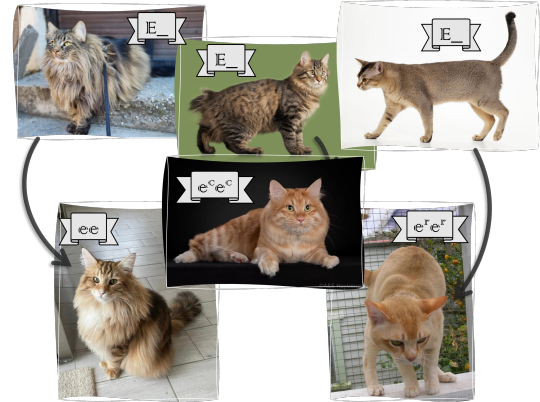
All three recessive variants are new mutations found recently in different breeds: the color amber in the 1990s in norwegian forest cats, the color russet in 2007 in burmese, and the color carnelian or serdolik in 2018 in kurilian bobtails (at least that's the first mention). We don't know anything about their interactions, or their effects on cats outside of their respective breeds.
The gene only effects eumelanin, so the O allele is epistatic over the it. However, because of the properties of the overpowering pheomelanin, every e allele is epistatic over agouti, so the tabby patterns will show up on aa cats as well.
Wide band (serine peptidase, CORIN): This hypothetic gene makes the yellow bands on the agouti hairs wider, resulting in a lighter, yellowish pelt.
dominant allele: Wb - eumelanin on normal sized area, darker cat (wild type)
recessive alleles: wbSIB, wbeSIB, wbBRI - eumelanin on reduced area, lighter cat (variant)

Ohhh, citizens of tumblr, we're really in it now. So. In the moment, we have, I believe, three mutations found on this gene: the sunshine (wbSIB) and extreme sunshine (wbeSIB) in the siberian breed, and the copper (wbBRI) in british cats. (I only show the sunshine and the copper here.) The novelty of these mutations means that the breeders still often call them simply golden instead of the new names, so it's difficult to find reliable data. Further complicating the situation, most likely both breeds have more wide band gene(s) beyond CORIN, and especially the copper cat above is the result of the combination of several wb genes.
Karpati (?): This unidentified gene makes the extremeties (face, ears, legs, tail) white kinda like a reverse colorpoint cat, and causes a roaning effect: scatters white hairs everywhere on the body.
dominant allele: K - whited extremities, karpati cat (variant)
recessive alleles: k - normal pigmant production, full colored cat (wild type)

Karpati seems to show intermediate inheritance with significantly more white on a homozygous then a heterozygote cat. This gene is studied for a very short time, and mostly on heterozygotes since they are much more common. The cats appearence changes during their life and also with the seasons: they born very similar to a fever coated kitten but with white ears, then to the end of their first year they almost completely lose the white (at least the heterozygous cats - the homozygotes become darker but still keep strange white patterns), then slowly gain it back as they age.
The karpati mutation is present in the stray cat population in middle-east Europe (including Hungary where I live, wahoo! and indeed, I can regularly see one or two karpaties in facebook adoptions groups and such). It's also introduced to some established breeds (LaPerm, Sphynx ect) and the creation of its own breed also began under the Transylvanian name.
2K notes
·
View notes
Text
Wet Beast Wednesday: flamboyant cuttlefish
The last few animals I covered on Wet Beast Wednesday haven't been all that colorful. Let's change that by introducing the flamenco dancer of the sea: the flamboyant cuttlefish. These tiny, toxic, tentacled, tykes are some of the most visually stunning animals you can see below the waves, at least when it comes to color and displays. Let's dig in.

(Image: a flamboyant cuttlefish. It is a small, squid-like animal with a round body and a large head with four pairs of arms. One pair is thicker than the others and is being used like legs. It's body is mostly purple, with yellow and white elements. Its eyes are large and white, with pupils shaped like the letter W. End ID)
Flamboyant cuttlefish (Metasepia pfefferi) are some of the smallest cuttlefish, with the larger females reaching a whopping 6-8 cm (2.4-3 in) in length. As with all cuttlefish, they have a mantle that makes up the body, with a fin running down each side. The head attaches to the mantle and has eyes with W-shaped pupils, a beak, eight arms, and two tentacles. The arms are broadened and flattened compared to other cuttlefish, with multiple leaf-like extensions called papillae. These papillae are also found on the head and around the eyes. The tentacles are transparent and kept folded up under the tentacles. When the cuttlefish spots prey, the tentacles, which have suckers on the end, shoot out and grab it. The tentacles are elastic and can stretch, allowing the cuttlefish to grab things up to 3 body lengths away. The grabbed prey is then quickly pulled in and dispatched with a powerful and venomous bite from the beak.

(Image: a flamboyant cuttlefish. This one is covered with brown and white stripes with yellow highlights and pink arms. Another one is in the background. End ID)
The most impressive thing of note about the flamboyant cuttlefish it its color. All cuttlefish, squid, and octopi have chromatophores, cells that contain pigment. By activating and deactivating chromatophores, these animals can quickly and radically alter their color at will. Flamboyant cuttlefish got their name from the extremely colorful displays they pun on, flaring their arms and turning their bodies a variety of colors including moving stripes of brown, white, red, and yellow. These displays are a form of aposematic signaling. Aposematic signaling is a type of display where an animal advertises to predators that it is not worth trying to eat. Aposematic coloration is a common form of this, where an animal uses bright colors to alert predators that it is venomous and/or poisonous. Flamboyant cuttlefish happen to be both. It was one thought that flamboyant cuttlefish were one of only 3 species of venomous cephalopod. Turns out almost every cephalopod is venomous, those three (the flamboyant cuttlefish and 2 species of blue-ringed octopus) are just the only ones potentially harmful to humans. It is likely that the common ancestor of all cephalopods was venomous and remnants of that venom persist in its descendants, even those that don't actively use venom as a major part of their survival strategy. Flamboyant cuttlefish also have poisonous flesh, which is rather rare amongst cephalopods. If the display is not enough, flamboyant cuttlefish also have the common cephalopod defense of releasing a cloud of ink to blind predators while they flee. Most pictures you will see of flamboyant cuttlefish have them doing a threat display in response to the presence of the photographer. When not threatened, they spend most of their time brown or sandy to blend in with the sediment. A flamboyant cuttlefish can switch from its camouflage colors to its threat display in 700 milliseconds.

(Image: a camouflaged flamboyant cuttlefish. It's body is the color of sand, making it look like a sandy rock. Its translucent tentacles are extended. End ID)
Flamboyant cuttlefish live in tropical ares of the Indo-Pacific from southern New Guinea to western Australia. The blue-ringed octopi mentioned above also live in Australia, because of course they do. All cuttlefish have an internal shell called a cuttlebone that is used to regulate buoyancy. The flamboyant cuttlefish's cuttlebone is unusually small, meaning they have trouble swimming. Instead, they use a modified pair of arms to walk over the sediment in a movement called ambling. Scientists didn't have to give it a name that cute, but they did, and that is why we love them. The cuttlefish prefer to occupy open areas with muddy or sandy sediment, but will also live in the rubbley outskirts of reefs. They are active during the day, unlike most cuttlefish, which are nocturnal. They hunt small fish and crustaceans.

(GIF: a flamboyant cuttlefish with its threat colors ambling across sand in a walking motion. Stripes on white and brown move down its back. End ID)
As with most cephalopods, the flamboyant cuttlefish is semelparous, meaning they mate only once in their lives. During mating season, males will attempt to attract mates by performing s series of displays. These displays use both color changes and movement of the arms to demonstrate reproductive fitness. Known displays include waving arms, splaying out tree arms, and moving forward to touch the female's arms. This can go on for over an hour. Females are very selective and will only mate with males that put on a good performance. When multiple males compete for a female, the males can show their courtship colors on one side of the body while showing an aggression display on the other side. When the female chooses a mate, she will signal it by splaying out her arms. The male then moves forward and inserts a modified arm called the heterocotylus into a hole in her mantle and deposits a packet of sperm. The whole process takes a few seconds. The male will stay to guard his mate after the mating, though unlike other cuttlefish species, he leaves before she lays her eggs. The female searches for a secluded place to lay her eggs, such as under a rock or in a coconut shell. She lays the eggs and covers them with a protective coating before leaving. Cuttlefish provide no parental care and the juveniles are born fully independent.

(Image: two flamboyant cuttlefish mating. The large female has her arms extended, allowing a much smaller males access to she can mate. End ID)
Flamboyant Cuttlefish are classified as data deficient by the IUCN, meaning there is not enough data to determine if they are endangered or not. There is no fishery for the species and it is currently unknown what their conservation needs are. Flamboyant cuttlefish are sometimes found in public aquariums and Montery Bay Aquarium has set up a captive breeding program.

(Image: flamboyant cuttlefish eggs. They are spherical and transparent. Visible within is a well-developed embryo, which looks like a miniature adult. End ID)
#wet beast wednesday#flamboyant cuttlefish#cuttlefish#cephalopod#mollusk#molluscs#invertebrate#invertebrates#marine biology#marine life#biology#ecology#zoology#animal facts#informative#educational#image described
202 notes
·
View notes
Text
What is Douma's official hair color?
Learning about his character design was one of the first and oldest research I have done for my fanfic: cold affections. While there are many fanon elements, I took seriously with what is canon first and foremost. His hair took me a while because I was surprised the information shared along the majority had the misconception that Douma is blonde. The yellowish or golden-like form. I do not blame anyone for thinking this misconception except those who kept pushing the idea after only seeing either glimpse the colored manga (I also don’t rely on the visual coloring because after trying to find source of whoever colored it — it seems it’s fanon. i could be wrong.) or the anime without knowing his backstory.
It is common knowledge that light objects reflects light while black absorbs it. If the object has a similar hue to the light, it absorbs the others and only reflects what is similar to it. Douma's hair reflection to the setting's light varies accordingly.


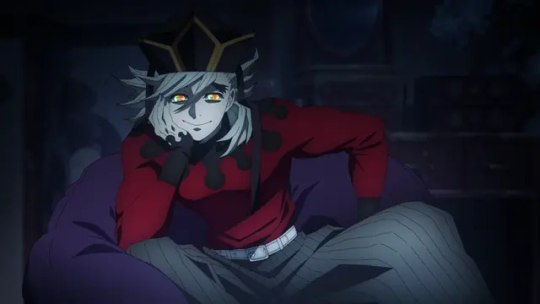
It may be his appearance in season three and the colored manga that people often call him blonde (yellow/gold). He looks blonde but he is not. That was the warm yellow lighting of the infinity castle.
I’m not knowledgeable about the means of blonde entirely so I have to search and understand the etymology. Blonde has a couple of different meanings. To hair it means fair or pale yellow. to racial characteristics it means someone of having fair hair and light complexion. to wood or other substance it means light in color.
Focusing on hair, blond or blonde, is also referred to as fair hair. A hair that has low eumelanin (the dark pigment). If you have high eumelanin in your body, it’d come out as either forms of black or brown. I used to hear this when I was in pharmacy moreover my anatomy and cosmetic subjects, however I don’t recall much anymore since it has been a while. But anyways, blonde still has a variation of shades like sandy, platinum, ash, strawberry, etc., and they all commonly consists of a hint of yellowish color.
Platinum blonde hair is second mostly shared among the fandom that douma has that type of color. I honestly don't reject the idea because it is similar to his official hair color. Platinum blonde has a cooler tone of ashy and pearly blonde with a hint of metallic shine. platinum is defined as a silver-white color.
The difference between silver and gray is silver having more metallic shine to it. With Douma's light hair having reflected light so vividly, to describe it having a shine, his appearance description being one of them as platinum blonde is close to accurate. In my fanfic, it is still being rewritten, but since the beginning I have described his hair to be silver or platinum due to lighting, and pale gray nonetheless.
So why gray? Pale gray specifically. Well it is said so in the English translation manga, according to his fuckass parents.

With m&m eyes and senior citizen hair color, he became a cult figure which makes sense… since Douma is written to how a unique looking person could affect his deluded peers, environment, and mostly himself.
Either way, there is also another official here to note, and that after reading this, with Douma's magical color changing hair, he might as well be a K-pop idol or DanTDM in the Minecraft story game.

I read an analysis from a person I personally trust because of their insightful analysis and studies on kny. They also made researched on Douma, even his hair. Here, is the link for more information about what they discuss:
I'll just briefly mention in here that they talked about Douma's official hair color description being as 白橡, "shirotsurubami," a white-ish shade of oak (very light brown or beige color.) Brown is desaturated colors of red, orange, and yellow. And I thought this circles back to him being close to blonde once again but I'm just overthinking. It is still a different description, yet one amongst official to Douma.
Personally, I think he was officially described this way because of how he appeared in the Infinity Castle and how the warm colored lighting affects his appearance, but that's just a humble opinion.
Either way, for me I am only following what Koyoharu Gotouge has intended to portray Douma after all this time. And these are the very evidence by the author themselves, as they personally colored these:
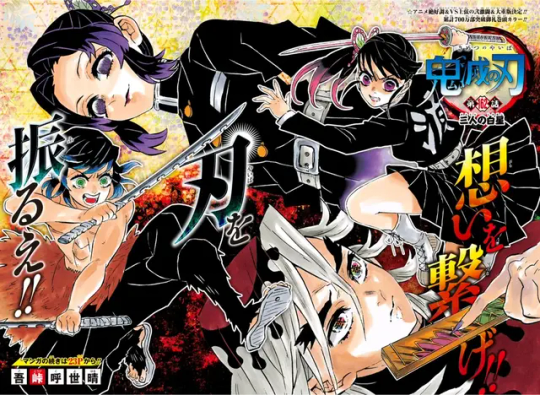
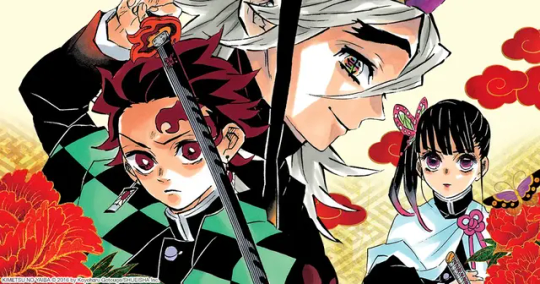
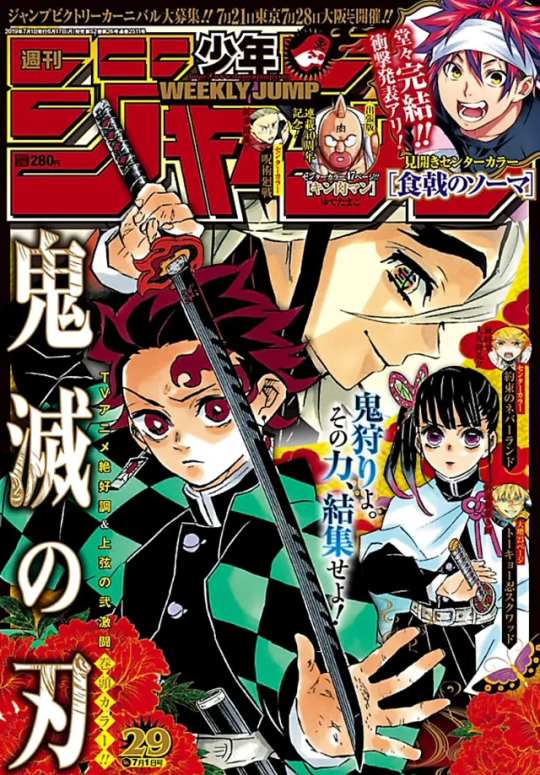
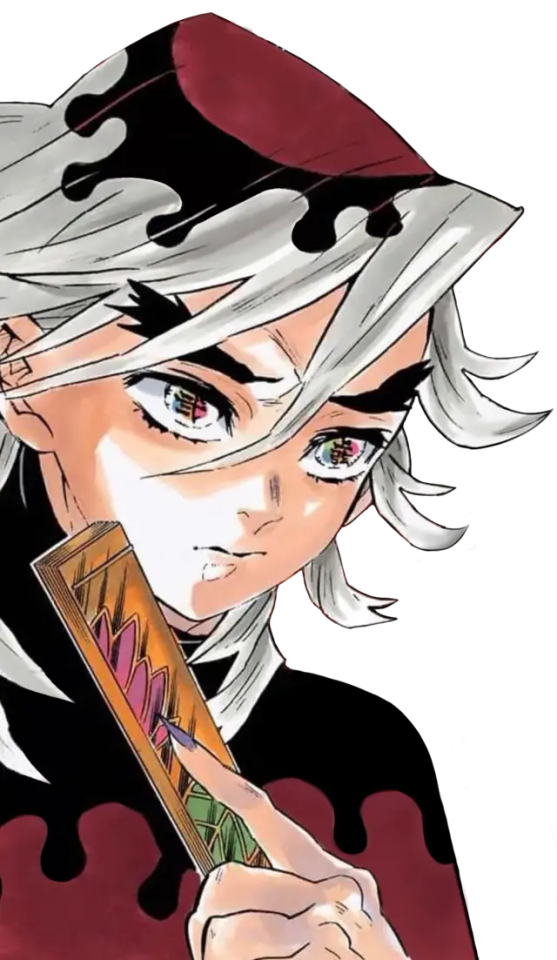
alright i sleep its 3:30 am here...
#douma#demon slayer#kimetsu no yaiba#kny#kimetsu no yaiba douma#demon slayer douma#kny douma#douma demon slayer#douma kny#discussion
45 notes
·
View notes
Text

Spring Has Sprung
Neteyam Sully x Avatar!Reader
Summary: Neteyam invites you to visit a naturally occurring water spring that he spotted while on patrol. Things of course get heated.
Word Count: 2.0k
TW: Smut.
<3<3<3<3<3<3<3<3<3<3
You were watching Neteyam cutting wood and stacking them into neat piles. Sitting on a tree nearby, feeling a bit like you were invading his privacy. The sun was shining down onto him through the thick branches of the trees. He was breathing hard and seemed to be aggressively doing his work. Like he was taking his anger out on the wood. He threw his ax down next to his last pile, resting his hands on his hips and letting his head tilt back. Once he was looking up, he saw you sitting on the tree above him. Smirking, he starts to climb up to accompany you.
“You could have come down and said hi,” he said, still breathing hard.
“Didn’t want to interrupt your focus, seemed like you were working really hard,” you said, picking a small twig out of one of his braids.
“Do you have any plans tonight?” he asks.
He made you so nervous, he wasn’t the type of person who said things half heartedly. Always making eye contact and speaking very confidently. Such a strong presence that at times you felt the need to avert your gaze. The two of you grew up together and are still really close. That being said, you noticed in the past couple months things were shifting. Your feelings were starting to develop romantically, which scared you. In fear that the bond you’d made as children would be soured by hormones or impulse. You couldn’t speak for him but there were times when you thought he felt the same way. Being more touchy or having conversations that weren’t exactly platonic. He set his hand on your knee, bringing you back to reality.
“No, why?” you asked.
“I found a really deep pool of water when I was on patrol and wanted to show you, if you’re open to that,” he suggested, so you agreed and then parted ways.
For the rest of the day all you could think about was nightfall. Excited to see what this adventure would bring. Helping your mom start the fire and make dinner felt like it took a eon. You are the oldest of 4 younger siblings so during supper you tried helping as much as you could. That was a big reason you and Neteyam got along so well. The stress of being semi responsible for all your kins mistakes made it easy to find common ground. You were so nervous that you didn’t have much of an appetite. After helping clean up and excusing yourself to go to The Hallelujah Mountains. It made you feel a little better knowing that wasn’t entirely a lie. You were meeting him at the tree, you just wouldn’t be staying there. Neteyam was already there with his Ikran, kicking around pebbles that were on the edges.. He immediately noticed you coming down and greeted your Ikran, petting her head. He explained that it wasn’t too long of a fly from here, as you went to remount your Ikran he pulled you up onto his. Wrapping your arms around his waist as he flew, holding on tighter whenever a sharp turn was made. You rested your cheek against his back and enjoyed the scenery. You weren’t out flying at night often so seeing the night sky and wildlife was truly amazing. As promised, it didn’t take long until you were landing.
You were really impressed by what you saw. It was a natural clear water spring. The water was sparkling and was so blue it looked pigmented. Tsawksyul and Melon Trees surrounded it, keeping it relatively hidden. As you admired, Neteyam raced past you. Jumping into the pool of water, not only splashing you but showcasing how deep the water ran. You took off anything you didn't want to get wet and followed suit. The water was cold but not bone chilling.
“Amazing right?” he asked, swimming towards the edge. Resting his arms on the outside of the pool.
“More than amazing,” you say, swimming over towards him. That was when you noticed all the bruises and cuts littered across his arms and chest.
“What happened,” you asked, pointing out all the injuries.
“Depends on what you’re talking about,” he says, letting his head drop back now resting against the outside edge of the pool. You were treading water right in front of him, running your finger along the healing gash on his bicep.
“This one?” you asked and without opening his eyes, he began to explain what happened.
“I was on patrol when an explosion happened, it spooked my Ikran and I went falling. Luckily a tree broke my fall but it also did some damage,” he explained.
“And here?” you asked, running your finger over his jaw where a clean scar was.
“My dad told my brother how he used to grow hair on his face. You know when he lived on the star he was born. Lo’ak and I were trying to imitate how he shaved with his hunting knife. I got nicked pretty bad,” he chuckled, feeling slightly embarrassed about the memory.
“Is it weird? Knowing your dad came from the Sky People?” you asked, now holding on to his shoulders. That way you could just float next to him in the water.
“Sometimes. Especially because we’re fighting an entire war against them,” he sighed.
You sat in comfortable silence for a while, not even noticing how close you’d drifted together. Bodies pressed against one another, you were taking in all the little details you’d never noticed before. Like how promodent his cupid's bow was and how muscular his arms really were. He looked so relaxed, almost like he was sleeping. Chest steadily rising and falling against yours. You laid your head on his shoulder and in kind, he rested his cheek against the top of your head. The sky was super clear and the stars were sparking so beautifully. There was hardly any wind, which allowed the two of you to stay in the water without being cold. You were dealing with a lot of inner turmoil. Wanting to ask if he had any love for you with all you had. However the fear of rejection was almost paralyzing. You admired so much about him, his intelligence, hunting skills and of course his looks. It made you feel insecure, like he looked past you when it came to things like romance. Using your arms to hoist yourself out of the pool. Grabbing your knife, you cut a melon off the tree. You heard Neteyam come out of the water and approach you from behind.
“What’s wrong?” he asks.
“I have a lot on my mind,” you say, sitting on the edge of the spring. Letting your feet soak in the water, him doing the same.
“Tell me,” he says, playfully leaning over and bumping his shoulder into yours.
“I really like how close we’re getting,” you say, avoiding eye contact. He leaned his head down in front of you. Playfully making the point that he wanted you to look at him.
“Good, me too,” he smiled.
“Is that all you feel? Are you happy being close or do you feel like we could be closer?” you ask, regretting the words even before they rolled off your tongue. He jokingly closes the gap of space between the two of you. As relieving as it felt not to be rejected right away, the suspense of an answer was drowning you,
“Neteyam..” you whine, taking a big bite of the melon. He waited until you were done chewing to grab your chin, making you look at him.
“You have juice all over you,” he laughed, dipping his hand into the water and wiping your mouth and neck. Both laughing, you wrap your hands around his wrist as he continues washing the stickiness from the melon off.
Eventually the laughs died down and instead of his entire hand brushing over your face, only this thumb was tracing your lip.
“Is this close enough?” he asks gently, leaning and catching you into a kiss.
He holds your face with his hands, weaving your lips together. When the two of you went to face each other, your bodies fell back into the water. This didn’t stop the encounter, only deepened it. The front of both your bodies were pressed together. Your hands were playing with his hair. He was running his hands up and down your body slowly, like he was trying to memorize every curve. Pressing yourself against his bulge caused a low moan to vibrate off his lips. You take the beaded top you were wearing off. As you do so, he lifts you slightly so your chest is just barely out of the water. He stared at you for a moment, admiring your beauty before turning his attention back down. He takes one of your nipples into his mouth, sucking and flicking his tongue. He was switching back and forth, like he couldn’t decide which one he liked more. Becoming rougher, testing the limits of your body.
You dip your head back, hair becoming soaked in water. The adrenaline pumping through your veins made you feel unreal. Like an out of body experience, not able to process what was happening. As much as you thought about how this would go, you never thought it would be like this. So passionate and beautiful. You started making out until your lips were swollen and tender. He pulls away and climbs out of the spring. Reaching for your hands, he pulls out shamelessly watching as the water runs off your body. He lays down in the soft thick grass growing near the spring. Pulling his shorts down and exposing himself. You straddle his lap, rubbing yourself against his shaft. The two of you are moaning from the friction. He pulls you down so that your lips are hovering over each other; every once in a while catching each other in a sloppy kiss. He lines himself up with your entrance, staying still and allowing you to sink down at your own pace.
For a while you stayed still, adjusting to the size of his length. In between kissing, you liked looking down and seeing the pleasure written all over his face. Once the sting from his size went away, you slowly started rocking your hips. You impulsively pull your braid over your shoulder. At first you thought Neteyam might be hesitant to tsaheylu but he did the same with his. After connecting, you watched his eyes dilate at an alarming speed. It was such an intense rush, being able to feel exactly what he was feeling without communicating at all. Like the breath was completely taken out of your body and replaced. Like the two of you were existing as one being and the feeling was intoxicating. He sat up, resting his back against one of the melon trees. Rocking your hips back and forth while making intense eye contact. His mouth was hanging open and eyebrows furrowed. His hands were covered in calluses so when he ran his hands up your things it would scratch you a bit.
You could tell he was getting close from how vocal he was becoming. Both of you were covered in sweat and breathing heavily. He wraps his arm around your waist, switching the position. Even though he was now in more control, he still was gentle while maintaining his strength. The amount of love you felt coming off him was overwhelming, enough to bring tears to your eyes. Wondering how a moment you were so worried would be careless could be so full of passion and comfort. Both of you were close, pressing his forehead against yours as the two of you came. Both of you were bucking your hips at your own erratic paces, riding out the high. Moaning and whining as the overwhelming pleasure flooded your bodies. Feeling completely exhausted he pulls out and lays down on the grass next to you. Pulling you into his arms before the two of you fell asleep.
#neteyam x reader#neteyam x you#neteyam x y/n#neteyam smut#neteyam soft smut
#neteyam sully#neteyam x avatar!reader#soft smut#avatar fanfiction#avatar smut
239 notes
·
View notes